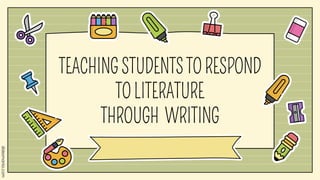
TEACHING-STUDENTS-TO-RESPOND-TO-LITERATURE-THROUGH-WRITING.pptx
- 2. #1 #2 #3 GENERAL INSTRUCTION ACTIVITIES BEFORE READING DURING READING AFTER READING. STRATEGIES THAT PROMOTE COMPREHENSION
- 3. Teacher may... Motivate students through activities that may increase their interest (book talks, dramatic readings, displays of art related to the text), making the text relevant to students in some way. Activate student’s background knowledge important to the content of the text by discussing what students will read and what they already know about its topic and about the text organization BEFORE READING
- 4. Students may... Establish the purpose of the reading Identify and discuss difficult words, phrases, and concepts in the text Preview the text (by survey the title, illustrations, and unusual text structures) to make predictions about its content Think, talk and write about the topic of the text. BEFORE READING
- 5. Teacher may… Remind students to use comprehension strategies as they read and monitor their understanding Ask questions that keep students on track and focus their attention on main ideas and important points in the text. DURING READING
- 6. Focus attention on arts in a text that require students to make inferences. Call on students to summarize key sections or events Encourage students to return to any predictions they have made before reading to see if they are confirmed by the text DURING READING
- 7. Students may… Determine and summarize important ideas and supportive details. Make connections between and among important ideas in the text. Integrate new ideas with existing background knowledge. DURING READING
- 8. Ask themselves questions about the text. Sequence events and ideas in the text. Offer interpretations of and responses to the text. Check understanding by paraphrasing or restating important and/or difficult sentences and paragraphs. Visualize characters, setting, or events in a text. DURING READING
- 9. Teacher may… Guide discussion of the reading. Ask students to recall and tell in their own words, important parts of the text. Offer students opportunities to respond to the reading in various ways, including through writing, dramatic plays, music, reader’s theater, videos, debate, or pantomime. AFTER READING
- 10. Students may… Evaluate and discuss the ideas encountered in the text. Apply and extend these ideas to other texts and real-life situations Summarize what was read by retelling the main ideas. Discuss ideas for further reading. AFTER READING
- 11. RETELLING STORY MAPS STORY FRAMES ACTIVITIES AND PROCEDURES FOR USE WITH NARRATIVE TEXTS
- 12. Involves having students orally reconstruct a story that they have read. Requires students to activate their knowledge of how stories work and apply it to the new reading Students engage in ordering and summarizing information and in making inferences. Assess how well students comprehend a story, then use the information to help students develop a deeper understanding of what they have read. RETELLING
- 13. SIMPLE RETELLING MORE COMPLETE RETELLING MOST COMPLETE RETELLING TYPES OF RETELLING
- 14. Identify and retell the beginning, middle and end of a story in order Describe the setting Identify the problem and the resolution of a problem SIMPLE RETELLING
- 15. Identify and retell events and facts in a sequence Make inferences to fill in missing information Identify and retell causes of actions or events and their effects MORE COMPLETE RETELLING
- 16. Identify and retell a sequence of actions or events Make inferences to account for events or actions Offer an evaluation of the story MOST COMPLETE RETELLING
- 17. These are visual representations of the elements that make up a narrative. STORY MAPS The purpose is to help students focus on the important elements of narrative-theme, characters, settings, problems, plot events, and resolution and on the relationship among those elements..
- 18. These are visual representations that focus students’ attention on the structure of a story and on how the content of the story fits its structure. Students use story frames as a way to activate their background knowledge of the elements of story structure and thus to organize and learn new information from a story. STORY FRAMES
- 19. K-W-L The purpose is to help students become good readers by learning to do the things that good readers do. It helps students learn to activate their background knowledge and to set purposes for reading. KWL stands for determining What I Know, What I Want to Learn, and reviewing What I Have Learned. ACTIVITIES AND PROCEDURES FOR USE WITH EXPOSITORY TEXT
- 20. What I Know – students discuss what they already know about a topic in the text they will be reading. What I Want to Learn – students discuss what they want to learn from reading the text and write down specific questions that they think may be answered in the text. What I Learned – after reading the text, students discuss what they learned from it. ACTIVITIES AND PROCEDURES FOR USE WITH EXPOSITORY TEXT